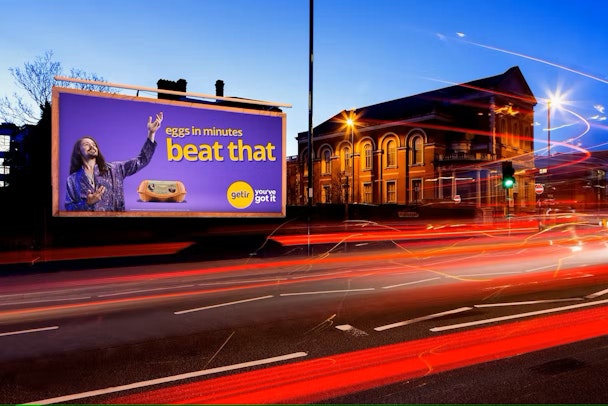As Getir gets a grip of Gorillas, can marketing ensure survival of grocery delivery?
After huge growth of rapid grocery delivery during pandemic, brands are now fighting to survive. We explore how a shift in marketing could save the sector.

Getir buys Gorillas for $1.2bn
Rapid grocery delivery brand Gorillas had become known for its distinctive marketing, but just two years after launch it has been bought by its rival Getir for $1.2bn – almost half its 2021 valuation ($2.1bn), showing a loss of confidence in the sector.
Grocery delivery has taken a battering in the past 10 months as the cost of living crisis sees consumers cut back on extravagant spending while inflation eats away at their margins. After the rapid growth of the category during the pandemic, brands are now fighting to survive.
Advertisement
A YouGov survey from September shows one in five Brits (21%) have been forced to make cutbacks to their essential food spending. Digging deeper, 16% of the British public have reported downgrading their staples to cheaper alternatives.
In the US, 40% of the population is reconsidering how they use food delivery services, according to a survey by cloud-based marketing tech company Zeta. Its chief data officer, Neej Gore, says: “The notion of having these services for your breakfast and lunches is a nice to have not a need to have.”
In 2021 investors plowed an estimated $14bn into the category funding brands like Weezy, Zapp, DoorDash, Jiffy, Fancy and Beelivery. A year later the sector has consolidated leaving six main category leaders.
Gorillas v Getir
According to The Financial Times, in the first half of 2022 marketing spend at Gorillas averaged €8 for every single order placed. The company managed to burn through more than €60m a month in May, June and July.
Gorillas has won praise for its creative advertising, including the ’Whatever London Wants’ campaign, which used consumer data to deliver locally relevant programmatic ads.
Tom Sussman, the head of planning at creative agency Leo Burnett, says that while Gorillas made a name for itself creating “incredibly distinctive” advertising, Getir’s branding has been more standout, taking the simple approach of just plastering its bright purple and yellow brand colors all over European cities. It has set itself apart from its competition with garish bus wraps, tube take overs and dressing its riders in head-to-toe purple.
“You’ve got to hand it to Getir because nobody is ignoring it – it isn’t trying to be clever, it is trying to be noticed,” says Sussman. “Getir has an uncompromising approach to building its brand color, making sure it’s at every touchpoint. Of all the brands, it is the one most likely to be salient.”
Regardless of what anyone thinks of Getir’s style of advertising, Sussman adds, it is highly likely to be the most remembered brand.
Advertisement
Marketing responsible spending
The commentators we speak to urge grocery delivery brands to market the behavior of doing fewer bigger shops. Any marketing that encourages consumers to do top-up shops during a cost of living crisis is likely to reflect badly on delivery brands.
“Selling top-up tomatoes is tone-deaf and not compassionate,” says Sussman. “Delivery brands have to understand what consumers are going through and deliver something that meets that rather than push the old messaging.”
Sussman says changing people’s behavior regarding how they use grocery delivery services to make it cheaper for them would be an incredibly “powerful” tactic for brands.
Suggested newsletters for you
Deliveroo’s vice-president of marketing Tina Koehler meanwhile tells The Drum that as marketing budgets get squeezed, there will need to be an increased emphasis on customer value. “Using relatable and timely customer insights in our marketing, we will ensure that our strategy remains relevant to consumers.”
In April, the brand dropped the global campaign ‘How Do You Deliveroo?’, which celebrated great food and the rituals that surround it. Koehler says: “Deliveroo used this insight to creatively play that back and remind customers that we are more than food delivery – we deliver moments and experiences that have become rituals in people’s lives.”
Pablo London worked on the ‘How do you Deliveroo?’ campaign and the agency tells The Drum how food delivery brands now have to add value beyond logistics, a spokesperson saying: “Food isn’t cargo, it’s one of our greatest passions. People are looking for a brand they can believe in and get behind, so for food delivery brands, marketing strategies need to communicate the role great food plays in our lives while also inspiring those who see it to say ‘that’s me!’ – otherwise, cutting through will be more challenging than ever.“
Expanding beyond groceries
To adapt to the downturn, delivery companies have been desperately trying other methods of monetization. Zeta’s Gore says brands that can “bridge the gap between food and other services” to make an order better value for money will be the ones that survive this period.
In the US, DoorDash has the highest market share with over 50%. “It is doing really well because it has combined breadth of options with a subscription model that people can get their heads around really quickly,” says Gore.
One other route, Gore explains, is retail media. “If you built a platform and can monetize the consumer without just selling a product, you will survive this and maybe even thrive.”
Uber recently spun its business out into a retail media offering, launching its Journey Ads solution to leverage its first-party data and reach its audience of 122 million monthly active users.
“If you rethink the platform as retail media to monetize in incremental ways, that could be a powerful driver for growth and margins,” adds Gore.

